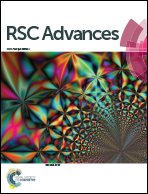Exploring the different ligand escape pathways in acylaminoacyl peptidase by random acceleration and steered molecular dynamics simulations†
Abstract
Acylaminoacyl peptidase (APH, EC 3.4.19.1) is a novel class of serine-type protease belonging to the prolyl oligopeptidase (POP) family. The members of the POP family are involved in numerous metabolic processes, such as signal transduction, maturation, and degradation of peptide hormones and neuropeptides, so they are a novel target in drug design for blood pressure control, amnesia depression, and Alzheimer's disease. The mechanism by which the ligands p-nitrophenyl caprylate (pNPC8) and Ac-Leu-p-nitroanilide (Ac-Leu-pNA) enter and leave the APH active pocket remains poorly understood. In this study, random acceleration and steered molecular dynamics simulations of the pNPC8 and Ac-Leu-pNA unbinding pathways from APH were performed to explore the possible unbinding pathways after docking the ligands into their proper position in APH. Three main pathways were observed most frequently, namely P1, P2A, and P3. By comparing the average force profiles and potential of mean force calculations, we found that P2A and P1 were the most favorable unbinding pathways for pNPC8 and Ac-Leu-pNA, respectively. We also found the new P3 unbinding pathway. Moreover, the residues lining the three pathways were analyzed for their roles in ligand unbinding. Arg526, which may hinder the ligand from leaving, is an important residue in P2A. The ligands escaping from APH via P1 and P3 may decrease the cation–π interaction in Phe485–Arg526 and Lys24–Phe41; thus, P1 and P3 were not the main unbinding pathways for the ligands except for Ac-Leu-pNA. This study provides new insights into the dynamics and interaction of the ligand escape pathways from APH.


 Please wait while we load your content...
Please wait while we load your content...